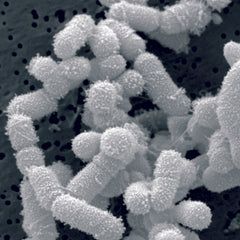The Science Behind Lanto Sinus
What is the sinus microbiome?
The sinus microbiome is the community of microbes (bacteria, viruses, fungi) that live in the sinuses. The sinus microbial community can become disrupted and imbalanced (dysbiosis) from illnesses, allergies, or antibiotics. Dysbiosis in the sinuses can cause a sinus infection or sinusitis.
Studies using modern state-of-the-art methods (such as genetic sequencing) find that people with chronic sinusitis have a different sinus microbiome than healthy people without sinusitis. They have fewer of some bacterial species, and an abundance of some other species. Researchers found that people with chronic sinusitis had less Lactobacillus sakei in their sinuses and more of other bacteria.
What is Lactobacillus sakei?
 Lactobacillus sakei is a keystone bacteria found in the sinuses of healthy humans (those without sinusitis), but diminished or absent in those with chronic sinusitis. Introducing Lactobacillus sakei into the nose and mouth can support and promote sinus health.
Lactobacillus sakei is a keystone bacteria found in the sinuses of healthy humans (those without sinusitis), but diminished or absent in those with chronic sinusitis. Introducing Lactobacillus sakei into the nose and mouth can support and promote sinus health.
Lactobacillus sakei has antibacterial effects against many species of bacteria. The strain used in Lanto sinus is especially effective against pathogenic bacteria such as Staphylococcus aureus, as well as having immune support and anti-inflammatory properties.
Studies also find Lactobacillus sakei in the digestive system of healthy adults.
"The concept of restoring the sinus microbiome with a specific sinus related probiotic such as Lanto Sinus is supported by some of the most current research studies.”
– Dr. Benjamin F. Asher, MD
Where else is Lactobacillus sakei found?
 Studies report that Lactobacillus sakei is found throughout the world. Currently there are over 230 known strains of Lactobacillus sakei, which were collected from meat, seafood, and vegetables. It was originally isolated years ago from sake or rice wine - thus the name Lactobacillus sakei. Studies from Korea have found it during fermentation in most brands of Korean kimchi.
Studies report that Lactobacillus sakei is found throughout the world. Currently there are over 230 known strains of Lactobacillus sakei, which were collected from meat, seafood, and vegetables. It was originally isolated years ago from sake or rice wine - thus the name Lactobacillus sakei. Studies from Korea have found it during fermentation in most brands of Korean kimchi.
More information:
Lactobacillus sakei is considered antibacterial, bacteriostatic, and bactericidal against many species of bacteria (Zagorec & Champonmier-Verges, 2017). Antibacterial means destructive to or killing bacteria or suppressing their growth, bacteriostatic means that it prevents the growth and reproduction of bacteria, and bactericidal means it kills bacteria. The food industry has studied and used L. sakei (e.g. as a sausage culture starter) because of its value against pathogens such as Listeria.
Also, clinical trials (Sung-Il Woo et al., 2010, Kim JY et al., 2013) show that Lactobacillus sakei supplements may benefit certain skin conditions such as atopic eczema-dermatitis syndrome (AEDS) and atopic dermatitis.
References:
Abreu, N. A., Nagalingam, N. A., Song, Y., Roediger, F. C., Pletcher, S. D., Goldberg, A. N., & Lynch, S. V. (2012). Sinus Microbiome Diversity Depletion and Corynebacterium tuberculostearicum Enrichment Mediates Rhinosinusitis. Science Translational Medicine, 4(151), 151ra124. https://www.ncbi.nlm.nih.gov/pmc/articles/PMC4786373/
Chaillou S, Lucquin I, Najjari A, Zagorec M, Champomier-Vergès M-C (2013). Population Genetics of Lactobacillus sakei Reveals Three Lineages with Distinct Evolutionary Histories. PLoS ONE 8(9): e73253. https://doi.org/10.1371/journal.pone.0073253
Cope EK, Lynch SV. Novel microbiome-based therapeutics for chronic rhinosinusitis. Curr Allergy Asthma Rep. 2015;15(3):504. doi:10.1007/s11882-014-0504-y https://pubmed.ncbi.nlm.nih.gov/25777787/
Lee K, Pletcher SD, Lynch SV, Goldberg AN, Cope EK. Heterogeneity of Microbiota Dysbiosis in Chronic Rhinosinusitis: Potential Clinical Implications and Microbial Community Mechanisms Contributing to Sinonasal Inflammation. Front Cell Infect Microbiol. 2018; 8:168. https://www.ncbi.nlm.nih.gov/pmc/articles/PMC5974464/
Yamashiro, K., Tanaka, R., Urabe, T., Ueno, Y., Yamashiro, Y., Nomoto, K., Hattori, N. (2017). Gut dysbiosis is associated with metabolism and systemic inflammation in patients with ischemic stroke. PLoS ONE, 12(2), e0171521. http://doi.org/10.1371/journal.pone.0171521
Woo, Sung-Il et al. (2010). Effect of Lactobacillus sakei supplementation in children with atopic eczema–dermatitis syndrome. Annals of Allergy, Asthma & Immunology, Volume 104 , Issue 4 , 343 - 348. https://www.sciencedirect.com/science/article/pii/S1081120610002036
Zagorec M, Champomier-Verges M-C (2017). Lactobacillus sakei: A Starter for Sausage Fermentation, a Protective Culture for Meat Products. Microorganisms, 5(3), 56. https://www.ncbi.nlm.nih.gov/pmc/articles/PMC5620647/
